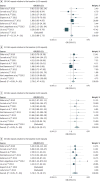Amyotrophic lateral sclerosis risk for spinocerebellar ataxia type 2 ATXN2 CAG repeat alleles: a meta-analysis
- PMID: 25285812
- PMCID: PMC4939089
- DOI: 10.1001/jamaneurol.2014.2082
Amyotrophic lateral sclerosis risk for spinocerebellar ataxia type 2 ATXN2 CAG repeat alleles: a meta-analysis
Erratum in
- JAMA Neurol. 2015 Jan;72(1):128
Abstract
Importance: Repeats of CAG in the ataxin 2 gene (ATXN2) in the long-normal range (sometimes referred to as intermediate) have been identified as modifiers of amyotrophic lateral sclerosis (ALS) risk. Prior studies have used thresholding considering various cutoffs for ATXN2 repeat length.
Objective: To calculate association between ATXN2 CAG repeat alleles and increased risk of ALS across multiple ethnic groups.
Data sources: The MEDLINE database was searched for studies published by December 29, 2013, reporting ATXN2 CAG repeat length in patients with ALS and controls.
Study selection: Studies were included if they reported original data on relative risks or odds ratios (ORs) from ALS and control populations for individual ATXN2 alleles. Review articles that reported no new data were not included in the analysis.
Data extraction and synthesis: Analysis of allele distribution was performed to ensure that all studies followed identical allele sizing. The ORs, 95% confidence intervals, and population attributable risk percentages were calculated according to standard procedures.
Main outcomes and measures: Occurrence of ALS associated with ATXN2 repeat alleles, expressed as ORs.
Results: Nine studies were analyzed, including 7505 controls and 6151 sporadic ALS cases. The ALS and control cohorts were recruited from different geographical and ethnic regions including the United States, French Canada/Canada, Belgium and the Netherlands, Germany, Italy, mainland China, Turkey, and Flanders-Belgium. The ATXN2 CAG repeat lengths ranged from 13 to 39 in patients with ALS and from 13 to 34 in controls. The ORs were less than 1.00 for alleles with 25 to 28 repeats. The OR was 1.55 for 30 repeats, but this elevation was not statistically significant (95% CI, 0.88-2.73). The ORs were 2.70 (95% CI, 1.47-4.93) for 31 CAG repeats, 11.09 (95% CI, 4.16-29.57) for 32 repeats, and 5.76 (95% CI, 1.79-18.57) for 33 repeats.
Conclusions and relevance: In contrast to prior studies with smaller numbers, risk for ALS associated with long-normal alleles is complex. Alleles with 27 and 28 repeats lower ALS risk slightly. The risk for ALS increases beginning with 29 repeats and reaches a maximum at 32 and 33 repeats. Of note, alleles with repeats of these lengths are known to be predisposed to meiotic expansion to full-penetrance mutant alleles. In patients with ALS, alleles with 31 to 33 repeats may have undergone preferential expansion in motor neurons during mitosis or DNA repair. Our meta-analysis provides a framework for counseling individuals with long-normal ATXN2 repeats.
Conflict of interest statement
Figures


Similar articles
-
PolyQ repeat expansions in ATXN2 associated with ALS are CAA interrupted repeats.PLoS One. 2011 Mar 29;6(3):e17951. doi: 10.1371/journal.pone.0017951. PLoS One. 2011. PMID: 21479228 Free PMC article.
-
ATXN2 CAG repeat expansions increase the risk for Chinese patients with amyotrophic lateral sclerosis.Neurobiol Aging. 2013 Sep;34(9):2236.e5-8. doi: 10.1016/j.neurobiolaging.2013.04.009. Epub 2013 Apr 28. Neurobiol Aging. 2013. PMID: 23635656
-
ATXN2 trinucleotide repeat length correlates with risk of ALS.Neurobiol Aging. 2017 Mar;51:178.e1-178.e9. doi: 10.1016/j.neurobiolaging.2016.11.010. Epub 2016 Nov 24. Neurobiol Aging. 2017. PMID: 28017481 Free PMC article.
-
Intermediate CAG repeat expansion in the ATXN2 gene is a unique genetic risk factor for ALS--a systematic review and meta-analysis of observational studies.PLoS One. 2014 Aug 22;9(8):e105534. doi: 10.1371/journal.pone.0105534. eCollection 2014. PLoS One. 2014. PMID: 25148523 Free PMC article.
-
Model organisms reveal insight into human neurodegenerative disease: ataxin-2 intermediate-length polyglutamine expansions are a risk factor for ALS.J Mol Neurosci. 2011 Nov;45(3):676-83. doi: 10.1007/s12031-011-9548-9. Epub 2011 Jun 10. J Mol Neurosci. 2011. PMID: 21660502 Free PMC article. Review.
Cited by
-
Emerging insights into the complex genetics and pathophysiology of amyotrophic lateral sclerosis.Lancet Neurol. 2022 May;21(5):465-479. doi: 10.1016/S1474-4422(21)00414-2. Epub 2022 Mar 22. Lancet Neurol. 2022. PMID: 35334234 Free PMC article. Review.
-
ATAXIN-2 intermediate-length polyglutamine expansions elicit ALS-associated metabolic and immune phenotypes.Nat Commun. 2024 Aug 29;15(1):7484. doi: 10.1038/s41467-024-51676-0. Nat Commun. 2024. PMID: 39209824 Free PMC article.
-
Cerebellar pathology in motor neuron disease: neuroplasticity and neurodegeneration.Neural Regen Res. 2022 Nov;17(11):2335-2341. doi: 10.4103/1673-5374.336139. Neural Regen Res. 2022. PMID: 35535867 Free PMC article. Review.
-
The role of de novo mutations in adult-onset neurodegenerative disorders.Acta Neuropathol. 2019 Feb;137(2):183-207. doi: 10.1007/s00401-018-1939-3. Epub 2018 Nov 26. Acta Neuropathol. 2019. PMID: 30478624 Free PMC article. Review.
-
The Clinical and Polynucleotide Repeat Expansion Analysis of ATXN2, NOP56, AR and C9orf72 in Patients With ALS From Mainland China.Front Neurol. 2022 May 6;13:811202. doi: 10.3389/fneur.2022.811202. eCollection 2022. Front Neurol. 2022. PMID: 35599735 Free PMC article.
References
-
- Pulst SM, Nechiporuk A, Nechiporuk T, et al. Moderate expansion of a normally biallelic trinucleotide repeat in spinocerebellar ataxia type 2. Nat Genet. 1996;14(3):269–276. - PubMed
-
- Fernandez M, McClain ME, Martinez RA, et al. Late-onset SCA2: 33 CAG repeats are sufficient to cause disease. Neurology. 2000;55(4):569–572. - PubMed
-
- Pulst SM, Santos N, Wang D, et al. Spinocerebellar ataxia type 2: polyQ repeat variation in the CACNA1A calcium channel modifies age of onset. Brain. 2005;128(pt 10):2297–2303. - PubMed
-
- Scherzed W, Brunt ER, Heinsen H, et al. Pathoanatomy of cerebellar degeneration in spinocerebellar ataxia type 2 (SCA2) and type 3 (SCA3) Cerebellum. 2012;11(3):749–760. - PubMed
-
- Lastres-Becker I, Rüb U, Auburger G. Spinocerebellar ataxia 2 (SCA2) Cerebellum. 2008;7(2):115–124. - PubMed
Publication types
MeSH terms
Substances
Grants and funding
LinkOut - more resources
Full Text Sources
Other Literature Sources
Medical
Miscellaneous

